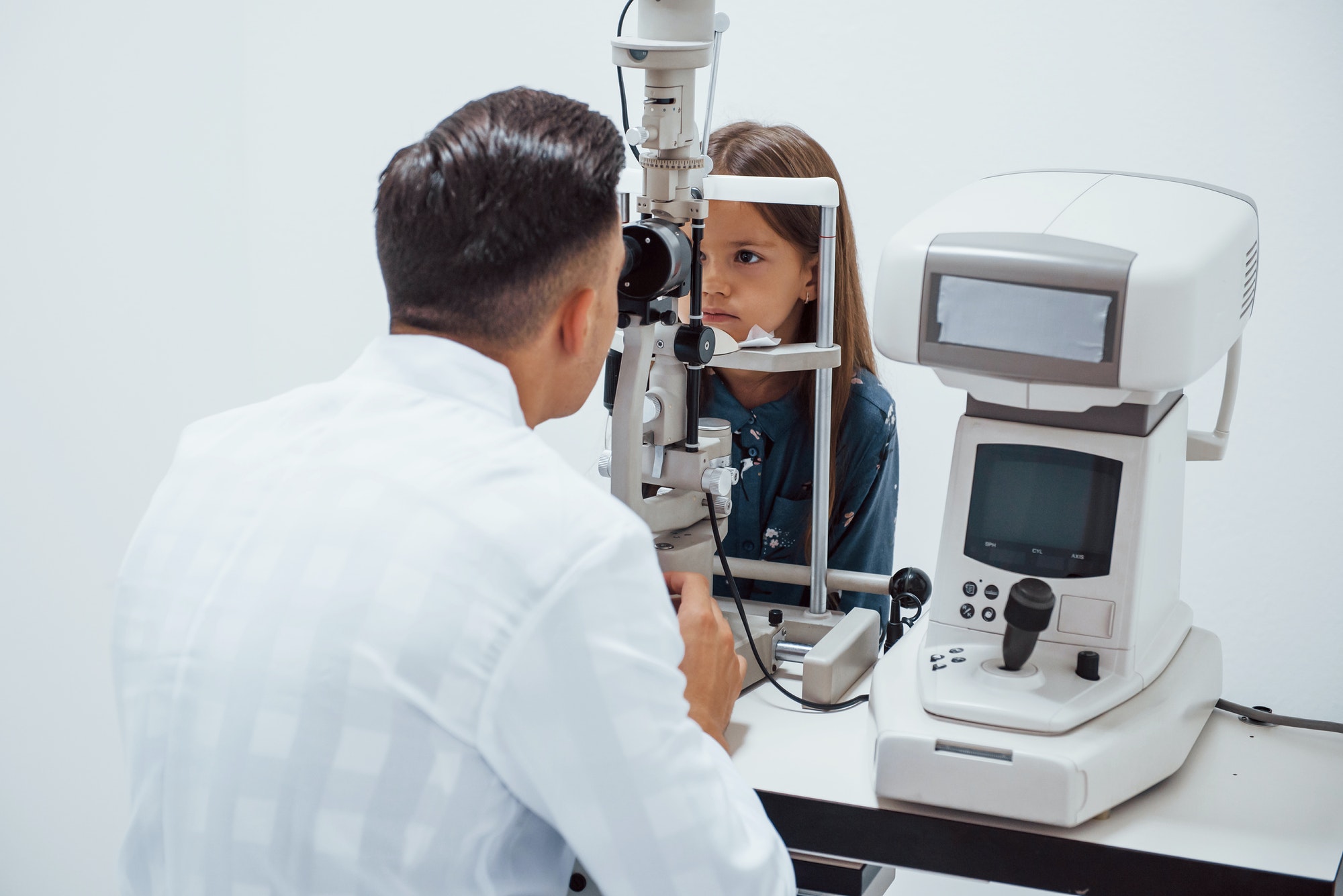
- Understanding Digital Eye Strain: Exploring the link between prolonged screen time and dry eyes.
- The Role of Blue Light: How exposure to blue light from screens affects eye health and contributes to dryness.
- Blinking and Screen Use: Investigating the reduced blink rate during digital device use and its impact on tear production.
- Ergonomics and Eye Health: Discussing proper screen positioning, lighting, and other ergonomic factors to reduce eye strain.
- Balancing Screen Time with Outdoor Activities: Highlighting the importance of breaks and outdoor time to mitigate the effects of excessive screen use on eye health.
(I) Understanding Digital Eye Strain: Exploring the Link between Prolonged Screen Time and Dry Eyes
With the widespread reliance on digital devices in modern life, people’s daily screen time continues to increase. However, this prolonged exposure to computer screens, smartphones, and other digital devices can lead to a discomfort known as digital eye strain. This article will delve into the close connection between digital eye strain and dry eyes, providing readers with a deeper understanding and targeted solutions.
Definition of Digital Eye Strain:
Digital eye strain is a discomfort syndrome caused by prolonged concentration on digital screens. Symptoms may include dry eyes, fatigue, eye tension, headaches, and a sensation of blurred or stinging vision. This fatigue is a result of intense visual work at a close distance on digital devices, placing a prolonged and constant focus on the eyes.
Relationship between Dry Eyes and Digital Eye Strain:
There is a significant correlation between digital eye strain and dry eyes. During extended use of digital screens, individuals often reduce the frequency of blinking, leading to insufficient lubrication of the eye surface. Blinking serves the purpose of distributing fresh tears across the surface of the eye, keeping it moist. However, when people are engrossed in screens, the blink rate significantly decreases, potentially causing dryness, irritation, and discomfort in the eyes.
Blue Light from Digital Screens:
Another factor contributing to dry eyes is the blue light emitted by digital screens. This high-energy blue light may not only have adverse effects on the retina but can also stimulate the eyes, leading to eye fatigue and dryness. Prolonged exposure to the blue light from digital screens may increase the risk of eye fatigue and dryness.
Methods to Alleviate Digital Eye Strain:
Take Regular Breaks: Set timed reminders to step away from the screen at regular intervals for eye relaxation and rest.
Eye Exercises: Perform simple eye exercises, such as eye rolling and focus adjustments, to relieve tension in eye muscles while using digital devices.
Adjust Screen Settings: Ensure the screen brightness is moderate, avoiding overly bright or dim environments.
Use Blue Light Blocking Glasses: Consider using glasses that block blue light to reduce the stimulation of the eyes.
Correct Vision as Needed: If necessary, address vision issues promptly to alleviate eye strain.
By understanding the intricate relationship between digital eye strain and dry eyes, individuals can take preventive and mitigating measures to maintain eye health and enhance adaptability to digital devices in their daily lives.

(II)The Role of Blue Light: How exposure to blue light from screens affects eye health and contributes to dryness.
In our modern, technology-driven era, prolonged exposure to digital screens has become an inherent part of daily life. One significant concern associated with this constant screen time is the exposure to blue light and its impact on eye health, including its contribution to dryness. Understanding the relationship between blue light, eye health, and dry eyes is crucial, especially in the context of therapeutic interventions such as dry eye therapy masks, relief masks, dry eye sprays, sleep goggles for dry eyes, and moisture chamber goggles designed to address the growing prevalence of digital eye strain and dry eye discomfort.
Blue Light and its Effects on the Eyes:
Blue light, a high-energy visible (HEV) light, is emitted by digital screens, LED lights, and other electronic devices. While exposure to natural sunlight is essential for regulating our circadian rhythm, excessive exposure to artificial blue light, especially during the evening, can disrupt our sleep-wake cycle and impact overall eye health. Studies suggest that prolonged exposure to blue light can contribute to digital eye strain, leading to symptoms such as eye fatigue, headaches, and dry eyes.
Dry Eyes and Blue Light:
The link between blue light and dry eyes is multifaceted. Blue light exposure is known to suppress melatonin production, the hormone responsible for regulating sleep. Disruption in the sleep-wake cycle not only affects overall well-being but also contributes to ocular surface irregularities, potentially leading to dry eyes. Additionally, blue light exposure can impact the meibomian glands, reducing the quality and quantity of the lipid layer in tears, further contributing to dryness and discomfort.
Therapeutic Solutions for Digital Eye Strain:
Dry Eye Therapy Masks: These specialized masks are designed to provide soothing heat therapy to the eyes, promoting the release of oils from the meibomian glands. This helps improve the quality of the tear film and alleviate dry eye symptoms caused by prolonged screen exposure.
Relief Masks: Similar to dry eye therapy masks, relief masks offer a combination of warmth and gentle compression, enhancing the effectiveness of therapeutic interventions for dry eyes.
Dry Eye Spray: Formulated with lubricating agents, dry eye sprays provide on-the-go relief by moisturizing the ocular surface. They can be especially beneficial for individuals who spend extended periods in front of screens.
Sleep Goggles for Dry Eyes: These specialized goggles create a barrier between the eyes and external factors, such as room lighting and digital screens, promoting a conducive environment for restful sleep and preventing further dryness.
Moisture Chamber Goggles: Designed to create a microenvironment that retains moisture around the eyes, these goggles are particularly useful for individuals with severe dry eye conditions exacerbated by prolonged exposure to blue light.
Incorporating these therapeutic solutions into a comprehensive eye care routine can play a vital role in mitigating the effects of blue light on eye health, providing relief from digital eye strain, and addressing the underlying causes of dry eyes associated with modern screen-centric lifestyles.

(III)Blinking and Screen Use: Investigating the Reduced Blink Rate during Digital Device Use and Its Impact on Tear Production
In the era dominated by digital technology, where screens have become ubiquitous in our daily lives, the simple act of blinking has taken on a crucial role in maintaining eye health. This section delves into the intriguing connection between reduced blink rates during digital device use and its profound impact on tear production, ultimately leading to discomfort and dry eyes.
The Blinking Mechanism:
Blinking is a natural and involuntary action that plays a vital role in maintaining the health and lubrication of the eyes. Each blink spreads a thin layer of tears across the cornea, preventing dryness and maintaining visual clarity. On average, a person blinks around 15 to 20 times per minute in normal circumstances.
Digital Devices and Reduced Blink Rates:
Extended use of digital devices, such as computers, smartphones, and tablets, often leads to a significant reduction in the frequency of blinking. This phenomenon is primarily attributed to the intense focus and concentration required when staring at screens. Studies suggest that individuals tend to blink only about 4 to 7 times per minute while using digital devices, significantly lower than the normal blink rate.
Impact on Tear Production:
The reduced blink rate during screen use has a direct impact on tear production and distribution. Blinking serves as a mechanism to evenly spread tears across the eye’s surface. When the blink rate decreases, tears evaporate more quickly, leading to insufficient lubrication. This can result in dry spots on the cornea, causing discomfort, irritation, and the onset of dry eye symptoms.
Digital Eye Strain and Dry Eyes:
The link between reduced blink rates during screen use and digital eye strain is evident. Prolonged screen time not only decreases the frequency of blinking but also contributes to a phenomenon known as “visual staring,” where individuals maintain a fixed gaze without breaks. This visual behavior exacerbates the reduction in blink rates and intensifies the symptoms of digital eye strain, such as eye fatigue, blurred vision, and, notably, dry eyes.
Mitigating Strategies:
Follow the 20-20-20 Rule: Take a break every 20 minutes by looking at something 20 feet away for at least 20 seconds. This practice encourages regular blinking and helps reduce eye strain.
Blinking Exercises: Incorporate intentional blinking exercises into your routine, especially during prolonged screen use, to maintain a more natural blink rate.
Artificial Tears: Use lubricating eye drops or artificial tears to supplement natural tear production and alleviate dry eye symptoms.
Adjust Screen Settings: Optimize screen brightness and font size to reduce the strain on your eyes, encouraging more frequent blinking.
Hydration: Stay adequately hydrated, as general hydration levels can influence tear production.
By understanding the intricate relationship between reduced blink rates during screen use and its impact on tear production, individuals can proactively implement these strategies to mitigate the effects of digital eye strain and maintain optimal eye comfort in the digital age.

(IV)Ergonomics and Eye Health: Discussing Proper Screen Positioning, Lighting, and Other Ergonomic Factors to Reduce Eye Strain
In the contemporary digital age, where a substantial portion of our lives revolves around screens, understanding and implementing proper ergonomic practices is pivotal for maintaining optimal eye health. This section explores the significance of ergonomics in mitigating eye strain, emphasizing aspects such as screen positioning, lighting, and various ergonomic factors that contribute to a more comfortable and healthier visual experience.
Proper Screen Positioning:
The positioning of screens plays a crucial role in determining the comfort and strain on the eyes. Ideally, screens should be at eye level, with the top of the screen roughly at or slightly below eye level. This positioning minimizes the need for excessive upward or downward eye movement, reducing strain on the neck and eye muscles. Additionally, maintaining an arm’s length distance from the screen helps promote a more relaxed and natural focus.
Optimal Lighting Conditions:
Inadequate or harsh lighting can significantly contribute to eye strain. Proper ambient lighting is essential to ensure a comfortable visual environment. Avoid glare and reflections on the screen by positioning the screen perpendicular to light sources and using curtains or blinds to control natural light. Task lighting can be beneficial for reducing eye strain, allowing for focused illumination without causing excessive contrast between the screen and its surroundings.
Blue Light Filters and Screen Settings:
The prevalence of digital screens exposes individuals to blue light, which has been associated with disruptions in circadian rhythms and eye strain. Employing blue light filters or adjusting screen settings to reduce blue light emission can be beneficial. Some devices offer built-in features for adjusting color temperature, allowing for a warmer and less harsh display, especially during evening use when exposure to blue light may impact sleep quality.
Ergonomic Factors for Comfort:
Proper Seating: Choose a comfortable chair that supports good posture, maintaining a neutral position for the spine and reducing strain on the eyes and neck.
Regular Breaks: Incorporate the 20-20-20 rule, taking breaks every 20 minutes to look at something 20 feet away for at least 20 seconds. This practice helps relax eye muscles and prevent prolonged strain.
Adjustable Furniture: Invest in adjustable furniture that allows individuals to customize their workspace according to their height and comfort, reducing the risk of awkward postures that contribute to eye and muscle fatigue.
Eye Exercises: Integrate simple eye exercises into the daily routine, promoting eye movement and reducing the likelihood of eye strain.
Customizing Workstations for Individual Needs:
Recognizing that ergonomic needs vary among individuals, it’s crucial to customize workstations to suit specific requirements. Adjustable desks, chairs, and monitor stands provide the flexibility needed to create a workspace that promotes good posture and minimizes eye strain.
By discussing and implementing these ergonomic considerations, individuals can create a conducive environment that significantly reduces eye strain, enhances overall comfort, and fosters healthier eye habits in the digital landscape.

(V)Balancing Screen Time with Outdoor Activities: Emphasizing the Importance of Breaks and Outdoor Time to Mitigate the Effects of Excessive Screen Use on Eye Health.
In the digital era, where screens are pervasive, striking a balance between screen time and outdoor activities is crucial for preserving overall eye health. This section emphasizes the significance of taking breaks and spending time outdoors to counteract the potential adverse effects of prolonged screen use on the eyes.
The Impact of Excessive Screen Time:
Extended periods of screen use can lead to a range of eye-related issues collectively known as digital eye strain. Symptoms include eye fatigue, dryness, blurred vision, and headaches. Prolonged exposure to screens, especially without breaks, can exacerbate these symptoms and contribute to long-term eye health challenges.
Benefits of Outdoor Time:
Spending time outdoors provides a refreshing contrast to the artificial and often intense lighting of digital screens. Natural light is essential for regulating the circadian rhythm and supporting overall well-being. Exposure to natural light not only reduces eye strain but also helps prevent the development of myopia, or nearsightedness, particularly in children.
Sunglasses and Sport Glasses:
For outdoor activities, wearing sunglasses or sport glasses is crucial. Sunglasses can block harmful ultraviolet rays, reduce eye fatigue, and protect the eyes from harsh sunlight. Sport glasses are designed to provide additional support and protection, suitable for various outdoor activities such as running, cycling, and hiking.
Taking Regular Breaks:
Incorporating breaks into screen-intensive activities is crucial for preventing digital eye strain. The 20-20-20 rule is a simple yet effective practice—every 20 minutes, look at something 20 feet away for at least 20 seconds. This helps relax eye muscles, reduce eye strain, and maintain a more comfortable visual experience.
Outdoor Activities to Support Eye Health:
Walking or Jogging: Physical activity increases blood circulation, including to the eyes, promoting overall eye health.
Nature Observation: Focusing on objects at varying distances in a natural environment exercises the eyes and reduces strain.
Sun Gazing: Gazing at the sun indirectly during safe hours can stimulate the production of important neurotransmitters and support eye health.
Gardening: Engaging in activities like gardening encourages regular breaks and offers a soothing environment for the eyes.
Digital Detox and Vision Wellness:
Periodic digital detoxes, where individuals consciously reduce screen time for a specified duration, can have significant benefits for eye health. During these breaks, engaging in outdoor activities becomes an integral part of promoting vision wellness.
Creating Healthy Habits:
Establishing a routine that balances screen time with outdoor activities is essential. Encourage children and adults alike to participate in outdoor sports, recreational activities, or simply take a walk in a natural setting. These habits not only benefit eye health but also contribute to overall physical and mental well-being.
Conclusion:
In the quest for a harmonious relationship between technology and eye health, incorporating breaks and outdoor activities is fundamental. By recognizing the importance of balancing screen time with moments of outdoor rejuvenation, individuals can take proactive steps to mitigate the effects of excessive screen use, fostering a healthier and more sustainable approach to digital living.


